
PREV ARTICLE
NEXT ARTICLE
FULL ISSUE
PREV FULL ISSUE
SELECTIONS FROM STACK'S BOWERS MARCH 2016 RARITIES SALE
Here are some selected lots from the upcoming Stack's Bowers March 2016 Rarities sale. I've excerpted some of the historical
commentary text. Read the online catalog for the full descriptions including grading and eye appeal discussion. -Editor
Lot 13007: Washington Funeral Urn Medal
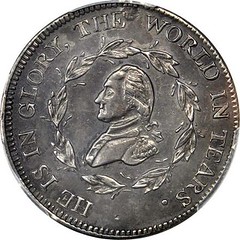 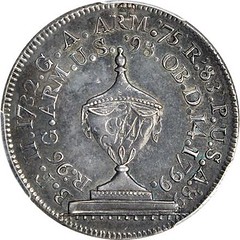
Historic Silver "1799" Washington Funeral Urn Medal "1799" (1800) Funeral Urn Medal. Baker-166A, Fuld Dies 1-B. Rarity- 6. Small Bust. Silver. AU-55 (PCGS). When George Washington died at his Virginia home on December 14, 1799, the fledgling nation was plunged into an extended period of mourning and celebrations of his life for months. Throughout the young United States, many events and funeral processions were held, and along with it a series of privately produced souvenir medals and badges. Among the best known are those issued by the City of Boston in 1800 for the two funeral processions, one on February 11 and a second on February 22. The medals, struck in silver, white metal, and even gold, were made with two distinct designs: the medals for the first procession bear a skull and crossbones motif, while the medals produced for the later event have a funeral urn instead. The medals were all intended to be worn around the neck from a black ribbon and were all pierced, which as a consequence, very few surviving specimens are found uncirculated or even undamaged. Here is an example that appears to have been purposefully not worn for very long and the hole plugged. Always popular among exonumists and collectors of Washingtoniana, the Boston funeral medals remain a key component of any specialist cabinet of early American medals.
So, is a piece that's supposed to be holed considered damaged if someone has plugged it? I'm not sure there will ever be a good
answer to that. Damage, as beauty, is in the eye of the beholder. Great item regardless, one that I would be happy to own. -Editor
To read the complete lot description, see:
Lot 13092: 1795 Draped Bust Silver Dollar
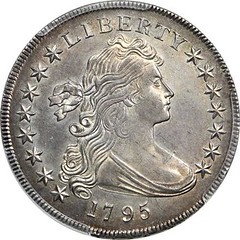

When Henry William DeSaussure became Mint Director in June of 1795, he set two goals: the first to get gold coins to actively circulate and the second to improve the appearance of each denomination with particular attention on the silver coinage. DeSaussure contracted with famed portrait artist Gilbert Stuart to prepare a depiction of Liberty intended to replace Robert Scot's Flowing Hair bust. Stuart's design, believed to have been a drawing of Ann Willing Bingham of Philadelphia, was then transferred into plaster models and punches by John Eckstein for Scot. Eckstein also prepared improved versions of the Small Eagle reverse punches which showed the eagle in intricate detail and style. For this work Eckstein was paid $30 in September. The resulting Draped Bust Small Eagle silver dollar is often heralded as a masterpiece from the early United States Mint, with Eckstein "deserving of a niche in the Pantheon of numismatic notables," as Q. David Bowers writes in The Encyclopedia of United States Silver Dollars: 1794-1804. De Saussure's tenure at the Mint was very short; in October of that same year he resigned his position in October 1795 due in part to illness and general dissatisfaction. While only there for the a few months, he made a long-lasting impression on the nation's coinage. While the Small Eagle reverse would only be employed until 1798, the Stuart/Eckstein Draped Bust was used for the rest of the series until coinage of silver dollars was suspended sometime in 1804. Two different die combinations were used for the new design. The die pair believed to have been struck first is the so-called Off-Center Bust variety, BB-51, which features Liberty appearing too far to the left from the center, a position used only on this die pair. This positioning was corrected to a more aesthetically pleasing centered location on the second variety, the BB-52 pair. The precise number struck and timing of each variety is unclear. Mint records from the time are not as thorough as scholars would prefer and much of what can be determined is conjecture. The commonly cited mintage figure of 42,738 is believed to be only a portion of the overall total of the 1795 Draped Bust Small Eagle dollars. Bowers posits that somewhere in the vicinity of 100,000 coins were produced of both BB-51 and BB-52 and that while the first deliveries likely took place in October, the later deliveries could have extended into 1796. In fact, the reverse die used for BB-52 was used as late as 1798, lending credence to this being the later of the two varieties. To read the complete lot description, see:
Lot 13198: 1799 Capped Bust Right Eagle
 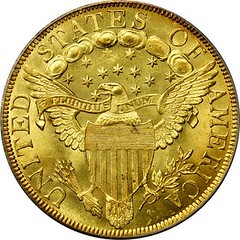
The Mint Act of 1792 established the eagle to be the fundamental basis for America's gold coinage which would be used in international commerce as an economic ambassador for the young nation. It was not until 1795 that coinage of the denomination commenced. Designed by Robert Scot, the obverse of the new coin bore a representation of Liberty facing right flanked by stars while wearing a cloth freedman's cap, with the legend LIBERTY above and the date below. The reverse featured an elegant yet somewhat scrawny eagle with spread wings holding a wreath in its beak, all the while clutching a palm frond in its talons. This simple and attractive design was used for all of three years until Scot completely redesigned the reverse to put forth more powerful and dramatic imagery. Scot's Heraldic Eagle reverse was based on the obverse of the Great Seal of the United States: in the center is a large eagle with outstretched wings and legs and the national shield across its breast. In its left talon is a clutch of arrows and in its right talon an olive branch of peace. The placement of the arrows in the left or sinister claw stands in contrast to the Great Seal, where the olive branch takes that position of honor. Scot may have not have been aware that this placement of the arrows conveys a more warlike posture in the language of heraldry. In the eagle's beak is a ribbon inscribed E PLURIBUS UNUM. Above its head is an array of 13 stars surmounted by an arch of clouds. The entire design is surrounded by the legend UNITED STATES OF AMERICA. The Heraldic Eagle reverse would be used until 1804 when production of the eagle was suspended for the next 34 years. In this year, the production of the eagle was stepped up to significant levels after having been struck in modest quantities since its inception. According to Mint records, 37,449 coins were struck in two major obverse design varieties, Small Stars and Large Stars. A total of six obverse and six reverse dies were employed in a total of ten die combinations: eight die pairings for the Small Stars variety and only two pairings for the Large Stars. Of the two major varieties of the 1799 eagle, the Small Stars type is widely thought to have been the first struck and is the slightly scarcer of the two, albeit not by much. At some point the Small Stars punch with long and thin points broke and a new punch was prepared with starts that shorter but much "fatter and puffier," as Garrett and Guth note. The resultant obverse die, Bass-Dannreuther Die 6, was mated to two reverse dies Bass-Dannreuther Die E and Die F, and used for the remainder of the year, producing an estimated 13,000 to 18,000 coins from these two pairs. To read the complete lot description, see:
Lot 13247: 1836 Pattern Gold Dollar
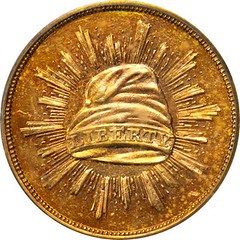 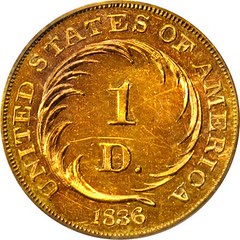
1836 Pattern Gold Dollar. Judd-67, Pollock-70. Rarity-5. Gold. Plain Edge. Proof-63 Cameo (PCGS). Obv: A liberty cap surrounded by a glory or sunburst, which design is similar to that used on certain coins of the Republic of Mexico. The band of the cap is inscribed LIBERTY. Rev: A coiled palm frond encircles the denomination 1 D. with the legend UNITED STATES OF AMERICA around the border and the date 1836 below. When Alt Christof Bechtler along with his sons opened his mint in Rutherfordton, North Carolina in 1831, he introduced a new type of coin, the gold dollar. As the Bechtlers became progressively more successful and their coins more widely accepted, Mint officials began taking an interest in their coins. They found that the Bechtler's coins were eagerly accepted in the region and were of good quality and weight, including the gold dollar. While the success of the Bechtler Mint eventually led to the establishment of mints in Charlotte and Dahlonega in 1838, officials were also taking their first tentative steps into launching a gold dollar of their own. in 1836, Treasury Secretary Levi Woodbury tried to convince Mint Director Robert Maskell Patterson to initiate a project to develop such a coin. Patterson, on the other hand, had no interest in striking a gold dollar, arguing that only "second-rate countries issued gold coins of such small size," as Q. David Bowers writes in his guide book to the denomination. With great reluctance, Patterson relented and directed Christian Gobrecht to design a pattern for the denomination. The obverse of Gobrecht's pattern gold dollar bore a striking resemblance to the "Libertad" coinage from Mexico of the time with the cap and rays motif. The reverse was a simple palm frond arranged in a circle surrounding the denomination. David Akers in his work on gold patterns states that 10 to 15 of the pieces were struck, however, additional research bolstered by certification figures puts the number closer to 30 to 40. The design was widely praised and considered a success but ultimately the project died on the vine, no doubt as a result of Patterson's ambivalence. It would not be until 13 years later until an official United States gold dollar would see general circulation. In 1844, examples were struck from the same dies as the originals but in a gold/silver alloy and again in 1859 a few more restrikes were made, with at least one of them known overstruck on an 1859 gold dollar. With its minimalist yet aesthetically pleasing design, Gobrecht's pattern gold dollars have long generated intense interest in the collecting community. One of the earliest appearances at auction occurred in 1855 when Bangs, Brother & Company of New York sold an example for $5.75.
I've long thought that the most educated collectors are those who incorporate patterns and errors into their cabinets. While errors
illuminate the manufacturing process, patterns tell the story of the evolution of coinage, putting it into a broader historical and
artistic framework. It's an important observation that the gold dollar denomination was first introduced by a private minter and
later adopted by the U.S. Mint, a process which would play out again in the Civil War with copper cents introduced by private merchants
and later being adopted by the Mint. -Editor
To read the complete lot description, see:
Lot 13250: 1849 Miners' Bank $10
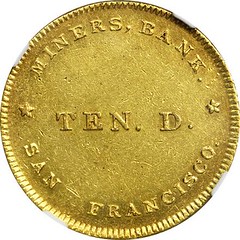 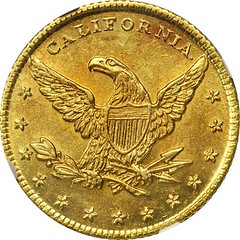
Undated (1849) Miners' Bank $10. K-1. Rarity-6. Copper Alloy, Plain Border. MS-62 (NGC). One of the early banking concerns of San Francisco, the Miner's Bank was established by the brokerage firm of Wright & Co., headed by partners Stephen Wright, Samual Haight, James Wadsworth, and John Thompson. Many details are scarce including precisely when both the bank and the brokerage firm commenced business, something made especially difficult considering the various other enterprises the partners were engaged at the same time. Intriguingly, an issue of bank notes issued by the Miner's Bank is known dated March 1, 1849, predating California's constitutional prohibition against currency as ratified in November of that year. It was not until July of 1849 that the Miner's Bank officially announced that it had opened its doors to business at its location on the corner of Washington and Kearney Streets. Evidently the firm had planned an issue of gold coins early on because the next month, they petitioned the Collector of the Port of San Francisco to grant permission to issue $5 and $10 coins in payment of import duties, even though the Customs House would not accept such pieces. Even though their petition was denied, the Miner's Bank went forward with the striking of coins in hopes to alleviate the specie shortage of the region as well as make a small profit. Because the bank did not have their own assay and refining equipment on their premises, the coins were struck at a different facility, most likely by the assay firm of Broderick & Kohler based on the testimony of James Wadsorth at a trial in which Broderick & Kohler were defendants where Wadsworth states that they produced the coins for the Miner's Bank. Only the $10 coins were produced in two different alloys, one with the gold alloyed with copper and another with silver. The issue appears to have been fairly sizable and initially the pieces enjoyed some success. However, things changed when while the bank was in the midst of a reorganization, the assayer for the New Orleans Mint examined a Miner's Bank $10 coin and found it was significantly underweight and worth only $9.65. The news spread quickly, the firm dissolved in January of 1850 and by April of the same year the Daily Alta California was reporting that, "The issue of the Miners' Bank is a drug on the market. Brokers refuse to touch it at less than 20 percent discount." As with many of the first of the privately issued territorial gold coins, large numbers of the coins later ended up in the melting pots of the United States Assay of Gold, and not long after that those of the San Francisco Mint.
Such a shame that so many of these private pieces ended up in the melting pot. All the more reason to cherish and study the remaining
survivors. Another great coin. -Editor
To read the complete lot description, see:

Wayne Homren, Editor The Numismatic Bibliomania Society is a non-profit organization promoting numismatic literature. See our web site at coinbooks.org. To submit items for publication in The E-Sylum, write to the Editor at this address: whomren@gmail.com To subscribe go to: https://my.binhost.com/lists/listinfo/esylum All Rights Reserved. NBS Home Page Contact the NBS webmaster 
|